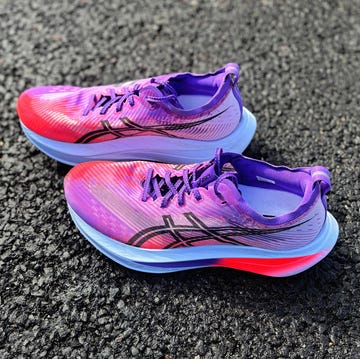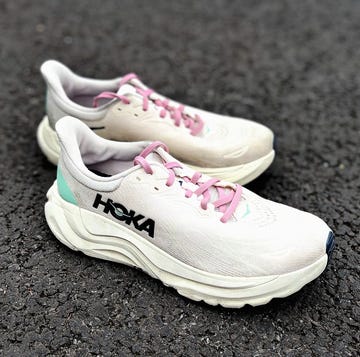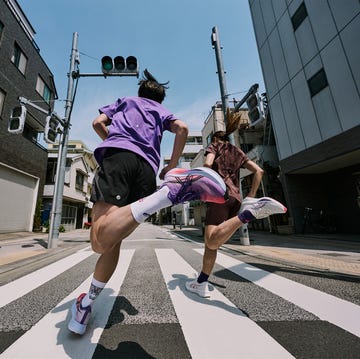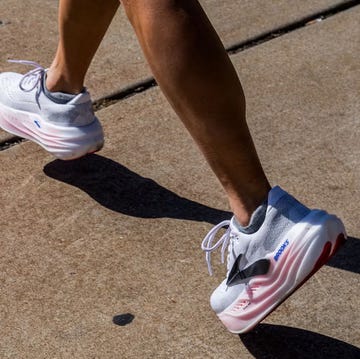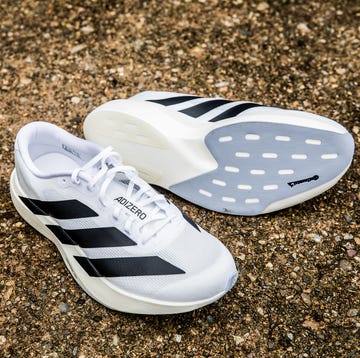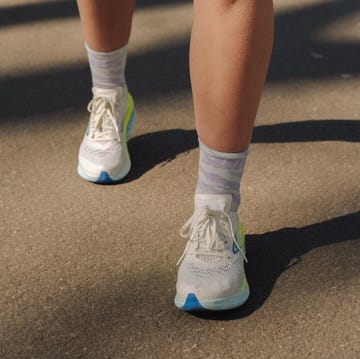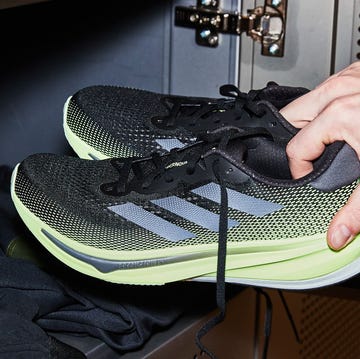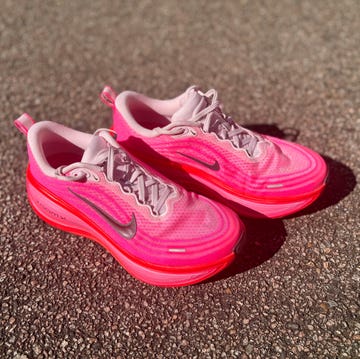For some runners, high heel-to-toe drop shoes (the difference between the height of the heel and the forefoot), which you’ll find on highly cushioned running shoes, can offer up some much needed comfort on the road. However, new research published in Frontiers in Sport and Active Living suggests that runners who wear this type of shoe are less likely to sense their foot strike patterns – and the study links that lack awareness on foot strike to increased risk of injury.
After six years of witnessing runners in physical therapy struggle with sensing the ground and understanding how to adjust their running form, Heather K. Vincent, lead study author and director of the UF Health Sports Performance Center at the University of Florida, tells Runner’s World that she sought to examine the relationships between different types of running shoes, foot strike and running-related injuries.
To do this, researchers surveyed 710 runners on their perceived foot strike patterns, shoe type and injury history. Runners self-reported foot strike as one of three options:
What everyone's reading
- Rear foot strike (when initial foot contact is made on the heel – in other words, heel strike)
- Non-rear foot strike (which could mean forefoot or midfoot strike)
- I don’t know
Runners also indicated the make, model, weight, heel height and heel-to-toe drop of their running shoes. They also answered whether they tried to change their foot strike in the last six months and if they had any running-related injuries within that same timeframe.
In another part of the study, each runner completed a 3D-motion running analysis in the same running shoes at a self-selected pace for 15 to 20 minutes to determine their actual foot strike.
Researchers then grouped and compared runners based on a their ability to accurately detect foot strike, running shoe type and injury history.
The key finding: confirmed heel strikers were least likely to accurately detect their foot strike patterns, especially if they wore a high heel-to-toe-drop shoe (anything above 6mm) or a heavier running shoe (weighing more than 255g for men and 249g for women).
More specifically, of the 710 runners who participated, only 67 out of the nearly 198 runners who originally self-reported as heel strikers were actually heel strikers (about 34%). Also, 103 of the 141 runners who didn’t know their foot strike were confirmed as heel strikers (about 73%).
In terms of injury, confirmed non-rear-foot strikers also had the lowest prevalence of running-related injuries in the last six months. Also, runners who ‘did not know’ their strike had the highest prevalence of running-related injuries, compared to those who self-reported non-rear-foot or rear-foot strike.
Based on these findings, Vincent recommends runners, especially those who run in a high heel-to-toe-drop or heavier running shoe, take some extra time to improve proprioception with the feet. (To do that, practice the foot exercises listed below.)
As Vincent notes, there’s a reason why runners may get their foot strike wrong when wearing highly cushioned shoes. ‘From the proprioceptive standpoint, it’s almost like putting big mittens on your hands and trying to type on a keyboard – you can’t feel it,’ she says. ‘It’s the same thing as the foot striking the ground.’
That’s a problem, because knowing how your foot strikes the ground could give you insight into potentially weak areas that may lead to injury. For example, rear-foot strikers may have trouble decreasing their impact load and therefore might be at risk of specific types of bone or soft tissue injuries, like tibial stress fractures or shin splints. Meanwhile, non-rear-foot strikers might be more at risk of developing achilles or calf-related issues, explains Vincent. Knowing this, you can short up the muscles surrounding these areas.
It’s important to note that this study doesn’t say that your running shoes or foot strike are the cause of your running-related injury. Rather, it highlights the importance of improving your body awareness. With that in mind, the study doesn’t champion one type of foot strike over another, so don’t obsess over changing your foot strike to combat your injury risk.
‘Foot strike is only part of the picture, so I would never counsel a runner to just modify foot strike alone,’ explains Vincent.
In fact, when it comes to avoiding running-related injuries, changing your foot strike isn’t high on the priority list, says Matthew Klein, researcher and assistant professor at George Fox University. Instead, shift your attention to sleep, nutrition and strength training, as well as avoiding overtraining – especially if you’ve already been injured.
‘Foot strike’s way down the line because it takes so much work,’ says Klein, ‘There’s also a lot of risk with changing foot strike, because if you change anything really quickly, you introduce a load to a new area that’s not used to that – and this can actually cause an injury.’
What to know before you run in highly cushioned shoes
So, should you ditch your highly cushioned running shoes if you fear that they’re interfering with your foot strike and running gait? Not necessarily.
After all, comfort comes first, so if you like to run in high heel-to-toe drop or cushioned running shoes because it feels good, keep going. Just keep the following advice in mind.
You need strong feet to avoid injuries, no matter which type of running shoes you choose, says Vincent. To build that strength, she recommends practicing feet pianos, toe scrunching, barefoot calf raises, toe adduction and abduction (moving inward and outward) and picking up objects with your toes, which research has proven to be effective in strengthening this area. These moves will also improve proprioception.
Klein agrees and says that adding balance and ankle-strengthening exercises to your list of moves is a must if you’re wearing these types of shoes. He also says that spending time walking in minimalist shoes can help improve your foot strength, which can balance out running in highly cushioned shoes.
In addition to strength training, research shows that maintaining a running shoe rotation can help to keep injury risk low, says Klein. So, rather than breaking up with your favourite pair of running shoes, just make sure that you have other, less cushioned shoes in your rotation.



